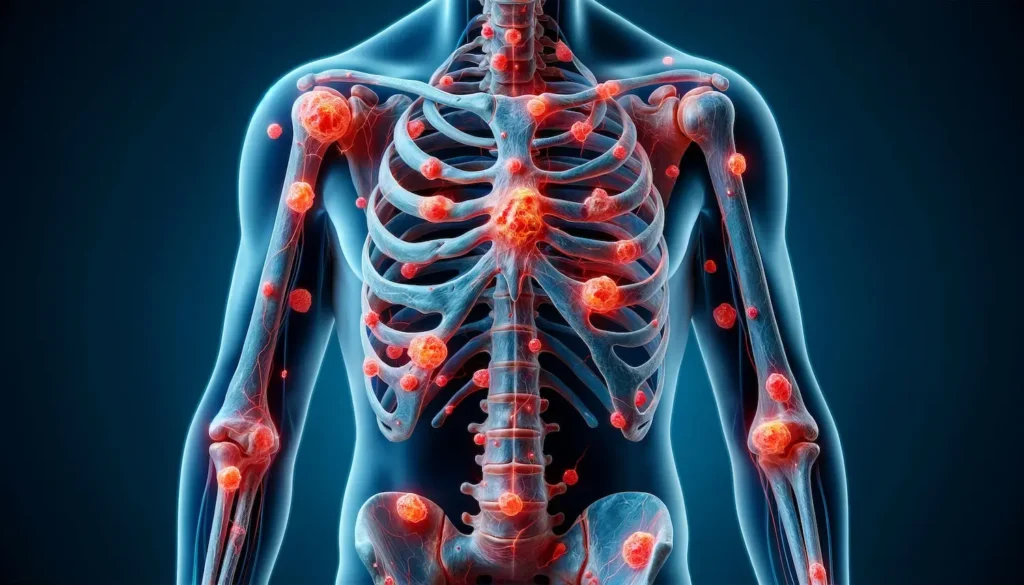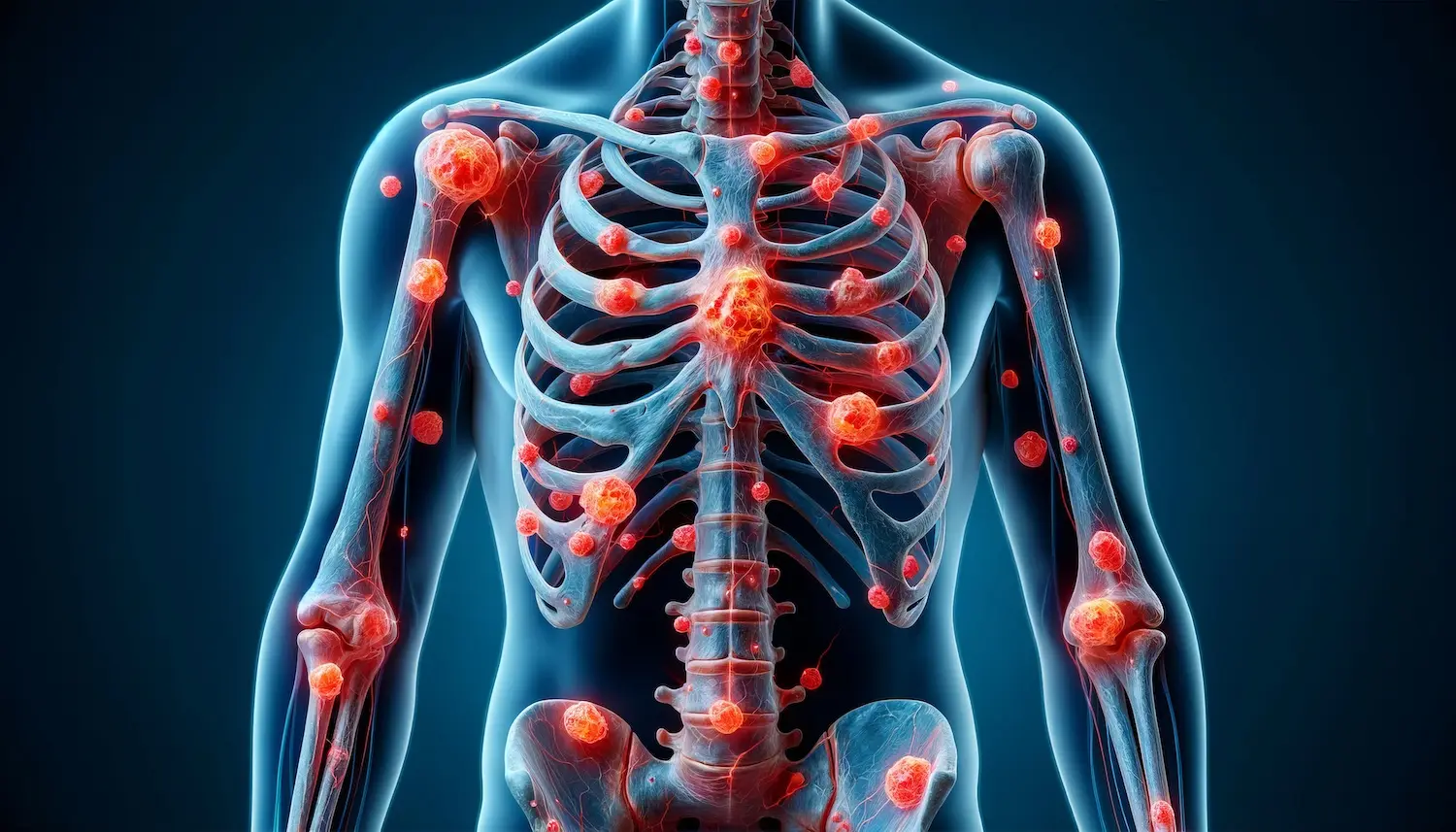Benign Bone Tumors Overview
Benign bone tumors are non-cancerous growths in the bone that are typically less aggressive than malignant tumors. While they do not spread to other parts of the body, they can still cause pain, structural damage, and other complications. At Fight Bone Tumors, Dr. Kishore B Reddy and our experienced team provide expert care for various types of benign bone tumors, utilizing advanced diagnostic techniques and personalized treatment plans.
Types of Benign Bone Tumors:
Osteochondroma:
- The most common type of benign bone tumor.
- Often found in children and adolescents.
- Usually occurs near the growth plates of long bones such as the femur, tibia, and humerus.
Giant Cell Tumor:
- Typically affects adults between 20 and 40 years old.
- Most commonly found at the ends of the long bones, particularly the knee.
- Can be locally aggressive and may require surgical intervention.
Enchondroma:
- A cartilage tumor that often occurs in the small bones of the hands and feet.
- Usually detected incidentally through imaging for other reasons.
Osteoid Osteoma:
- A small, painful tumor usually found in the long bones of the legs.
- Commonly affects young adults and adolescents.
- Often treated with minimally invasive techniques.
Fibrous Dysplasia:
- A developmental abnormality where normal bone is replaced with fibrous tissue.
- Can affect any bone but is often found in the skull, femur, tibia, and humerus.
Symptoms:
The symptoms of benign bone tumors can vary depending on the type and location of the tumor, but common signs include:
- Persistent pain or discomfort in the affected area
- Swelling or a noticeable lump
- Reduced range of motion in the adjacent joint
- Pathological fractures (fractures that occur with minimal trauma)
- Bone deformities or growth abnormalities in children
If you experience any of these symptoms, it’s important to seek medical evaluation for an accurate diagnosis and appropriate treatment.
Diagnosis:
The diagnostic process for benign bone tumors typically involves:
- Physical Examination: Initial assessment to evaluate symptoms and overall health.
- Imaging Tests: X-rays, MRI, and CT scans to visualize the tumor and assess its size and location.
- Biopsy: In some cases, a sample of the tumor tissue may be taken and analyzed under a microscope to confirm the diagnosis and rule out malignancy.
Accurate diagnosis is crucial for developing an effective treatment plan.

Treatment Options:
Treatment for benign bone tumors depends on the type, size, and location of the tumor, as well as the symptoms it causes. Our comprehensive treatment approach includes:
Observation:
- In cases where the tumor is asymptomatic and not causing any harm, regular monitoring with periodic imaging may be sufficient.
Surgical Removal:
- Curettage: Scraping out the tumor from the bone.
- En bloc Resection: Removing the tumor in one piece along with a margin of healthy bone.
- Bone Grafting: Filling the defect left by the tumor with bone graft material to promote healing and restore structural integrity.
Minimally Invasive Techniques:
- Radiofrequency Ablation (RFA): Using heat to destroy the tumor cells, particularly effective for osteoid osteomas.
- Cryotherapy: Freezing the tumor cells to kill them, sometimes used in combination with other surgical techniques.
Medications:
- Pain management and anti-inflammatory medications to alleviate symptoms.
- In some cases, medications that help strengthen the bones may be prescribed.
Our multidisciplinary team collaborates to develop personalized treatment plans aimed at achieving the best possible outcomes for our patients.
Support and Rehabilitation:
Dealing with benign bone tumors involves more than just medical treatment. We offer comprehensive support services to help patients and their families through this journey:
Physical Therapy:
- Essential for recovery post-surgery, aiding in regaining strength and mobility.
Emotional Support:
- Counseling and support groups to address the emotional and psychological impacts of dealing with a bone tumor.
Nutritional Guidance:
- Tailored dietary plans to support overall health and recovery during and after treatment.
Follow-Up Care:
- Regular check-ups to monitor for recurrence and manage any long-term side effects of treatment.
FAQ's
Benign bone tumors are non-cancerous growths in the bone that are typically less aggressive than malignant tumors. They do not spread to other parts of the body but can still cause pain, structural damage, and other complications.
Common types include osteochondroma, giant cell tumor, enchondroma, osteoid osteoma, and fibrous dysplasia.
Symptoms can include persistent pain, swelling, a noticeable lump, reduced range of motion, pathological fractures, and bone deformities.
Diagnosis typically involves a physical examination, imaging tests (X-rays, MRI, CT scans), and sometimes a biopsy to confirm the diagnosis.
Treatment options may include observation, surgical removal (curettage, en bloc resection), bone grafting, minimally invasive techniques (RFA, cryotherapy), and medications for pain management and bone health.
Curettage is a surgical procedure where the tumor is scraped out from the bone. It is often used for treating benign bone tumors.
Yes, potential side effects can include pain, swelling, risk of infection, and challenges related to rehabilitation post-surgery.
Managing side effects can involve rest, physical therapy, proper nutrition, pain management medications, and emotional support through counseling or support groups.
We offer physical therapy, emotional support, nutritional guidance, and regular follow-up care to monitor for recurrence and manage long-term side effects.
You can schedule a consultation by calling us at +91 9032027279 or emailing info@fightbonetumors.com. Our team is here to provide personalized care and support.





